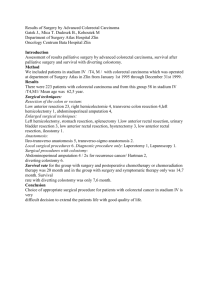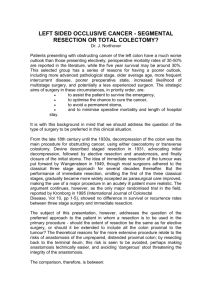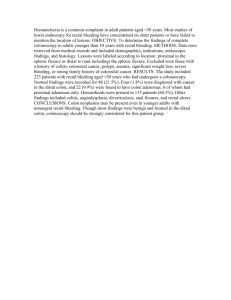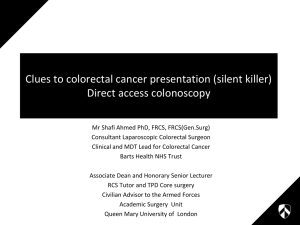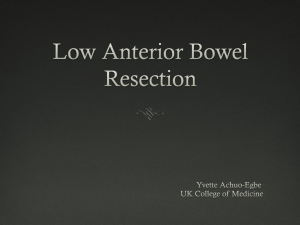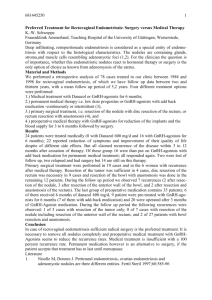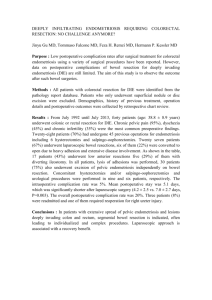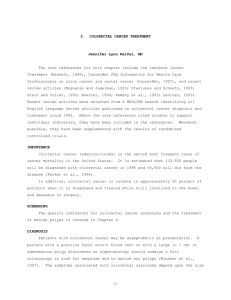stapler
advertisement
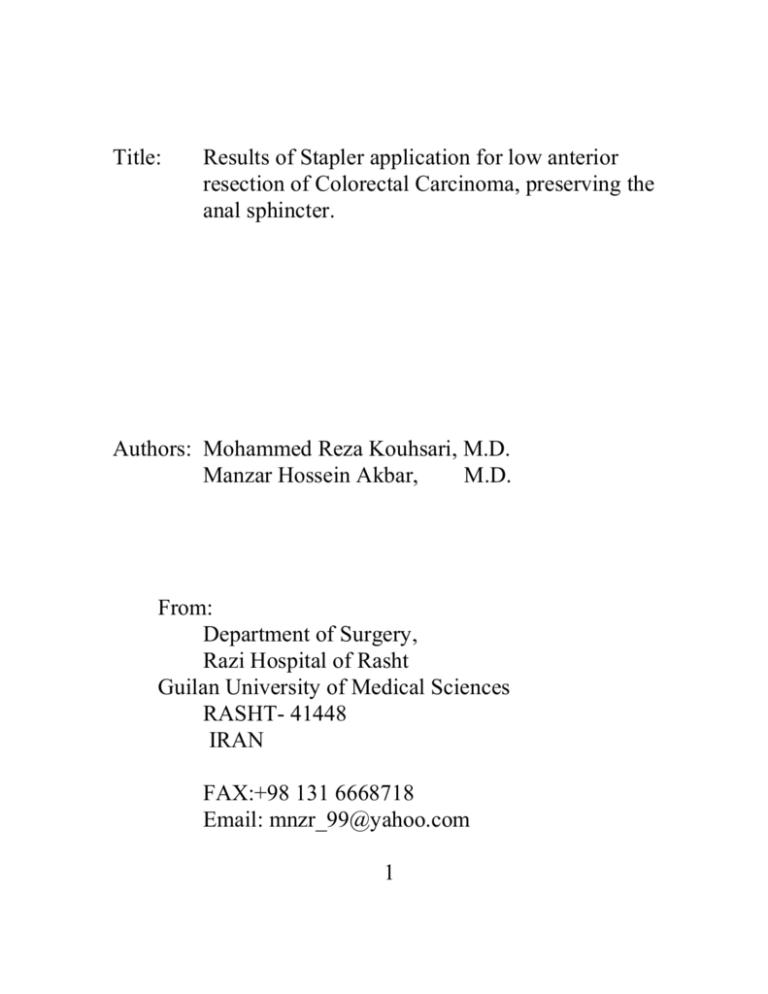
Title: Results of Stapler application for low anterior resection of Colorectal Carcinoma, preserving the anal sphincter. Authors: Mohammed Reza Kouhsari, M.D. Manzar Hossein Akbar, M.D. From: Department of Surgery, Razi Hospital of Rasht Guilan University of Medical Sciences RASHT- 41448 IRAN FAX:+98 131 6668718 Email: mnzr_99@yahoo.com 1 Title: Results of Stapler application for low anterior resection of Colorectal Carcinoma, preserving the anal sphincter. Authors: Kouhsari, M.R. Akbar, S.M.H. Abstract Colorectal carinoma is one of the common malignant neoplasms of alimantery canal. Most important problem in surgery of Rectal carcinoma is the limited anatomy of short pelvis and the presence of sphincter nearby. Resection of sphincter alongwith the tumor in a classic surgery was accompanied with the permanent colostomy. Use of surgical stapplers has solved this problem . We used circular stappling techniques for low anterior resection of Rectal carcinoma ; and studied the results in 14 patients (5 females and 9 males)within the age group of 26 - 72 years.All patients were observed regularly for 3 years postoperatively . None of the stappler related complication appeared in these patients. Function of anal sphincters of all patients was well preserved and volunterily controlled in all cases . Among early complications , wound sepsis was seen in 2-cases which was managed by simple drainage .In second year of follow up , signs of stricture were evedent on endoscopy in 2 cases (14.2%) ; tumor recurrance was the cause in both cases , one of which was managed by reoperation using anastomosis and stappler application again ; the other one died of multiple metastasis. After introduction and successful applications of stapplers , colostomy has become obsolete in our surgical hospital Keywords: Surgical stapler / Colorectal Carcinoma/ 2 Title: Results of Stapler application for low anterior resection of Colorectal Carcinoma, preserving the anal sphincter. Introduction : Colorectal carinoma is one of the common malignant neoplasms of alimantery canal in Western world (1). This disease is not uncommon in Iran too, particularly the Northern area of Iran at the Caspean seashore.Most important problem in surgery of Rectal carcinoma is the limited anatomy of short pelvis and the presence of sphincter nearby (2) . Resection of sphincter alongwith the tumor in a classic surgery was accompanied with the permanent colostomy(3),causing discomfort Only because of colostomy problems, many of the patients in this part of world refused surgery and prefered early deaths. Use of surgical stapplers has solved this problem.The abitity to construct low anastomosis deep within the pelvis , has improved with the advent of intraluminal surgical stappling instruments(4) Method : From June 1992 to May 1996 we applied CEEA surgical stapplers with catridge No 31. While doing colorectal anastomosis in 14 patients of 3 Rectal carcinoma . We used circular stappling technique for low anterior resection of Rectal carcinoma ; and studied the results in 14 cases . These patients included 5 females and 9 males within the age group of 26 - 72 years. All tumors were diagnosed to be malignant on Biopsy prior to surgical resection . Distance of tumor from anal sphincter varied from 3 cm. to 8 cm. Patients were followed up periodicaly every three months, or at the time of any related complaint. Intraoperative results and postoperative complications of this technique were studied. Surgical technique : Low anterior resection with coloanal anastomosis is a technically challenging operation . First , positioning the patient in the lithotomy position using Allen stirrups is essential ; care should be taken to protect the legs and hands from injury.We recommend placing an extra towel or sheet beneath the patient's sacrum in order to raise the pelvis away from the operating table. second both the abdominal and the perineal surgeon should use a headlight to facilitate a meticulous dissection and anastomosis within the pelvis . After exploring the abdomen , the sigmoid and left colon are mobilized.We usually take down the splenic flexure because extra 4 mobilization is almost always needed. We usually divide the bowel in the upper sigmoid or distal descending colon and after dividing the mesentery we ligate the superior hemorrhoidal artery just distal to the take - off the left colic artery. We try to preserve the hypogastric plexus and nerves behind the superior hemorrhoidal artery as well as the nerves on each pelvic side wall . We perform our pelvic dissection down to the levator ani muscles under direct vision. Finaly rectum is cut and the stappler is closed to make a circular end to end anastamosis. Results : All patients were observed regularly for 3 years post operatively . None of the stappler related complication appeared in these patients . Function of anal sphincters of all patients was well preserved and Volunterily controlled in all cases. Among early complications, wound sepsis was seen in 2-cases which was managed by simple drainage . In second year of follow up , signs of stricture were evedent on endoscopy in 2 cases (14.2%); tumor recurrance was the cause in both cases , one of which was managed by reoperation using anastomosis and stappler application again ; the other one died of multiple metastasis . 5 Discussion: Aim of this study was to examine suruival rate , local recurrence, quality of life and sphincter function ; all these parameters in our cases were found comparable to the similar studies in other centers (6,7,8). The main goal of treating rectal cancer is to relieve the patient of symptoms or potential symptoms caused by the local tumor while curing disease. A second goal is to minimize morbidity and maximize the patients quality of life,which has been achieved in most of the patients managed by Stappler application. Intraoperative complications, such as hemarrage or perioperative mortality did not appear, fortunately in our cases. Miller & Moritz from Salzburg,Austria (6) reported 4.7% perioperative mortality in 103 cases with adenocarcinoma of rectum. They also reported clinical leaks in 9.5% of their cases, while only one patient (7%) had leakage in our study. On 36 months follow up we found 14.2% anastomic stricture which was caused by the local recurrence. The overall rate of local recurrence following low anterior resection of Rectal carcinoma has been reported 8.5% - 28.6%. (8,9,10) Tokyo workers have reported recurrent colonic cancer developing at the site of a stapled stump which is thought to be caused by the implantation of cancer cells. 6 Stapplers have other advantages too, such as reduction of operation time, reduction in time of anesthesia, less blood loss, soft manipulation of the tissues, smaller inflammatory reaction; and a better and faster function of the anastomosis.(5,6) The stappling devices are real surgical progress with correct indications and adequate operative technique. The economical effort is justified and entirely compensated by the major benefits obtained for the patients . After introduction and successful applications of stapplers, colostomy has become obsolete in our surgical hospital. Patients of colorectal cancer preserve functioning and volunterily controlled anal sphincter with a better quality of life than the colostomy. 7 References: 1- Kodner I J . Fry , RD ; Fleshman J.W. Colon , Rectum and Anus ; In; Shwartz , Shires, Spencer. Principles of Surgery. 6th ed . Mc.Graw Hill New york 1994 . pp1280 2- Preservation of the anus in the therapy of distal rectal cancers surgical clinics of North America , Vol , 77 No .1/1997 / 79 . 3- Williams NS , Johnston D : The quatity of life after rectal excision for low rectal cancer , B. J. Surg . 70: 460- 62 ; 1983 4- Schiessel R , Karner H, Herbst F . etal Intersphincteric resection for low rectal tumors Br, J. Surg. 81;1376 -1378 ; 1994 5- Terashima - S ; Wantabe - S ; Ito ; F ; et ; al An umprooved techniqie for low anterior resection surg. Today ; 1996 ; 26 ( 70 ) ; 857 -9 6- Miller - K ; Moritz E . Circular stapling technigues for low an terior resection of rectal carcinoma . Hepato gastrenterology ; 43 (10): 823-31; 1998. 7- Pollard CW , Nivatvongs S, Rojanasakul A . et al ; Carcinoma of the rectum : Profiles of intraoperative and early post operative complications ; Dis. Colon Rectum 37 ; 866-874;1994 . 8- Braun J ; Treatner KH ; Winiceltau G ; et al . Results of intersphincteric resection of the rectum. Am. J. Surg ; 163 ; 407 - 412; 1992 . 9-Mc Dermotl FT , Enker WF , Pihle , et. al Local recurrence after potentially curative resection for rectal cancer in a series of 1008 patients . Br . J . Surg . 72 ; 34 - 37 , 1985 . 10- Teunoda - A ; shibusawa - M ; Kawamura M; etal . Recurrent colonic cancer developing at the site of a stapled stump. Surg. today , 1997 ; 27 (5) . 457 - 9 . 8
